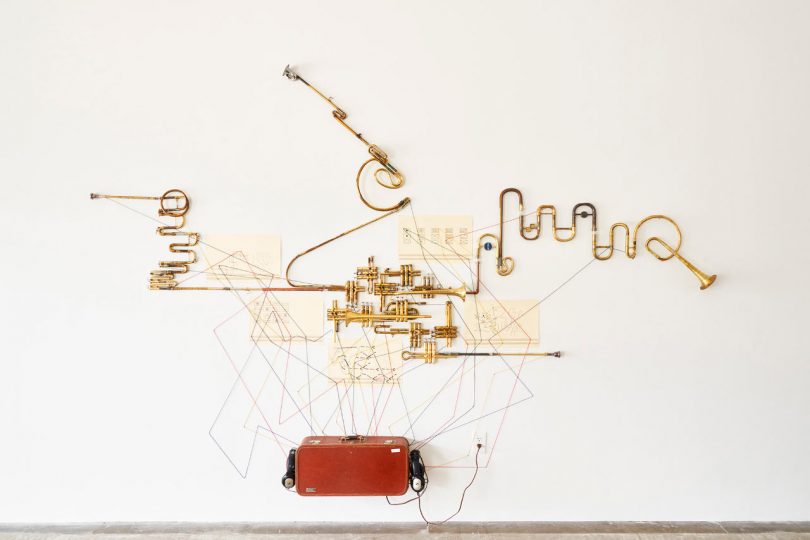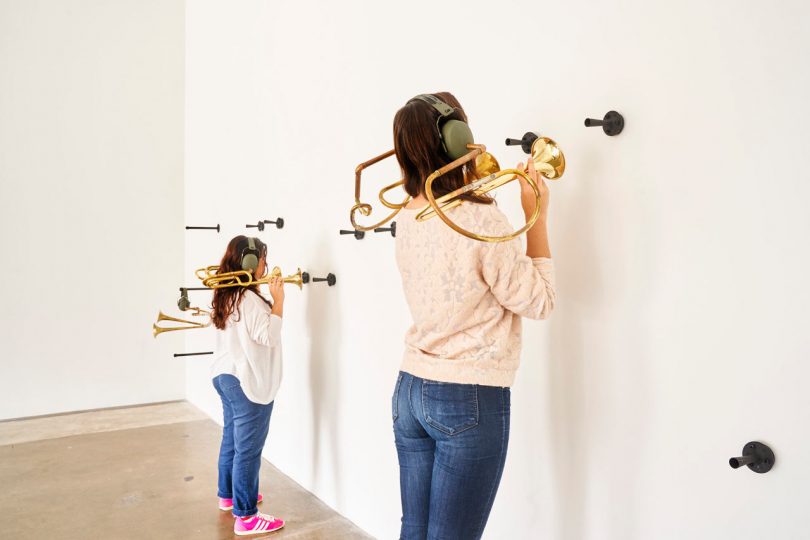The brass horns in the sculpture of Steve Parker make music… but not how you’d expect. In this electrified sculpture, a viewer’s touch activates beautiful and unexpected recordings. Several of his interactive works are on view at the Cue Art Foundation in New York in the must-see (and must hear) exhibition titled “Futurist Listening” curated by Assistant Curator of the Whitney Museum, Marcela Guerrero.
“Ghost Box” (above) is a wall sculpture created from pieces of brass horns arranged in the design of a schematic drawing of a WWII-era radio. Visitors are encouraged to wear the attached headphones and gently touch any piece of metal. Doing so activates a variety of recorded sounds – from the high-pitched rhythmic beat of Morse Code, to a symphonic escalation, or the scratchy murmur of an old radio transmission. Every touch is a surprise – though my favorite sound interaction is possibly the most simple: a recording of a single note that feels like it was made from the very horn you’re touching. After individually sampling each piece, viewers can layer and mix the sounds with multiple hands (or… if you can manage, to contact multiple pieces with a single stretched hand). Each sound mixes together impressively well to create endless possibilities of poetic music.
Beyond their playfulness, each sculpture references a darker past. In “Ghost Box” for example, Parker is not just referencing World War II in the visual design, but also mentions that every sound is a reference to “coded songs from the Underground Railroad.”
On an adjacent wall, “ASMR Étude” invites visitors to wear double-trumpeted earphones: the gallery calls them “wearable acoustic locators, modeled after German models from the mid-twentieth century”. Once wearing the device, visitors are encouraged to approach a wall of black protrusions and attach themselves, to discover the sounds of strange whispers and static sampled from ASMR artists.
The use of ASMR (Autonomous Sensory Meridian Response) is also connected to a history of war, community, and anxiety. The exhibition specifically notes that ASMR is “sometimes used to treat anxiety, PTSD, and insomnia.”
One of the most intriguing works in the exhibition is also the most quiet. A series of drawings are at the entrance of the exhibition, collectively titled “Ghost Scores”.
Each drawing consists of handfuls of colorful pins that suspend a curving electrical wire. Unframed, these pins pierce through the paper and directly into the wall. Additional ink lines on the paper are either inspired by music scores, ballet choreography notations, or tactical maps from the (very real) “Ghost Army”.
Ghost Armies were “deception units” in WWII that aimed to confuse the enemy with fake radio transmissions and other sounds. A nearby wall text explains:
“The Ghost Army was an Allied Army tactical deception unit during World War II. Their mission was to impersonate other Allied Army units to deceive the enemy… utilizing inflatable tanks, sound trucks, fake radio transmissions, scripts, and sound projections…”
The black marks on the paper display the “visual language” of those Ghost Armies.
Steve Parker’s artwork is on view at Cue Art Foundation through February 12th, 2020. My only suggestion is to bring a friend: You will want more than 2 hands.
What: Steve Parker: Futurist Listening, curated by Marcela Guerrero
Where: Cue Art Foundation, 137 West 25th Street, New York, NY
When: January 9 – February 12, 2020
Images courtesy Cue Art Foundation © Steve Parker, photographed by Sarah Frankie Linder unless otherwise noted.
from WordPress https://connorrenwickblog.wordpress.com/2020/01/21/circuit-boards-of-sound-the-sculpture-of-steve-parker/












No comments:
Post a Comment